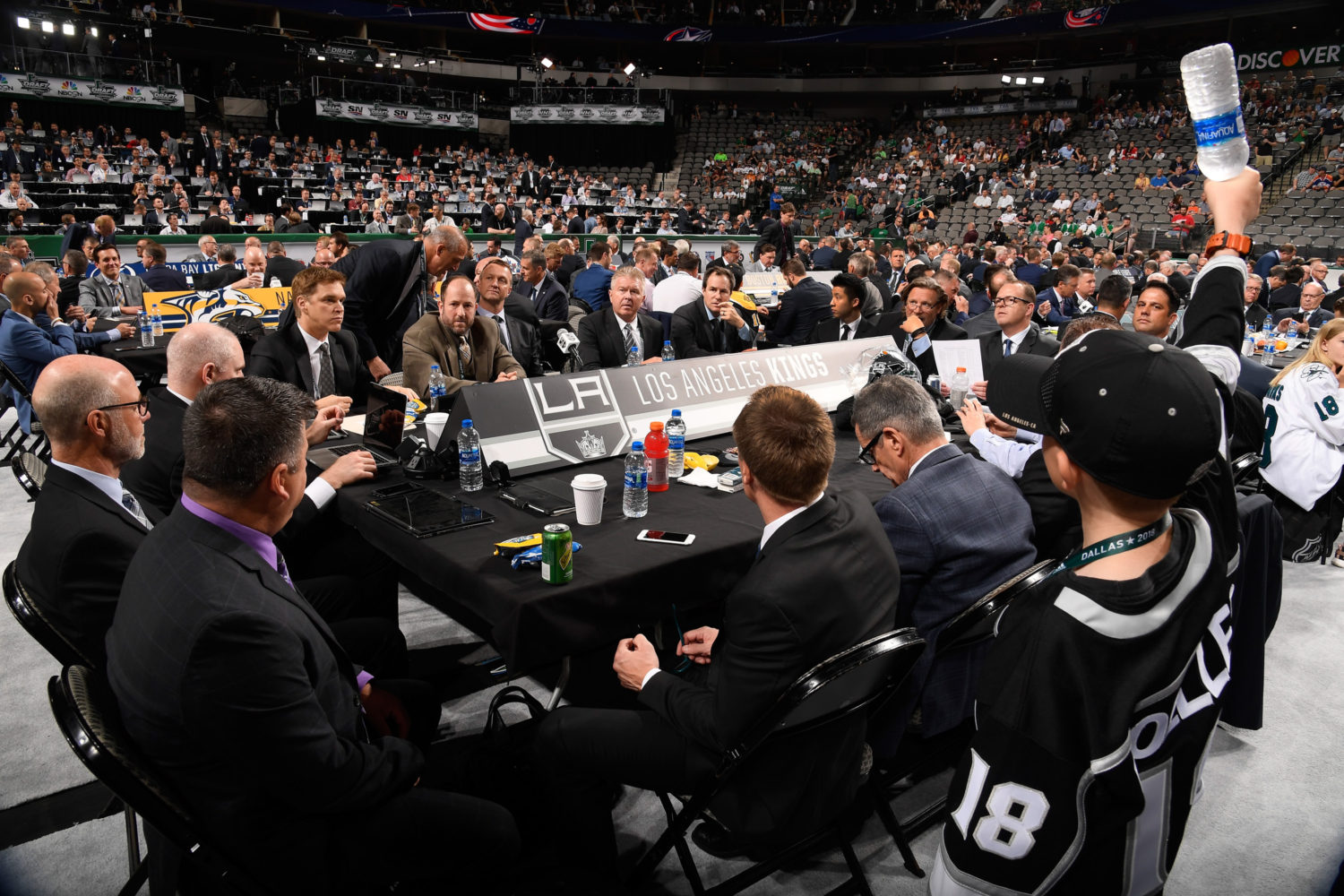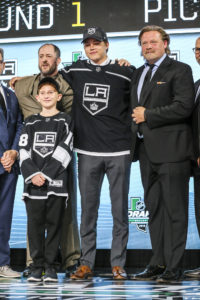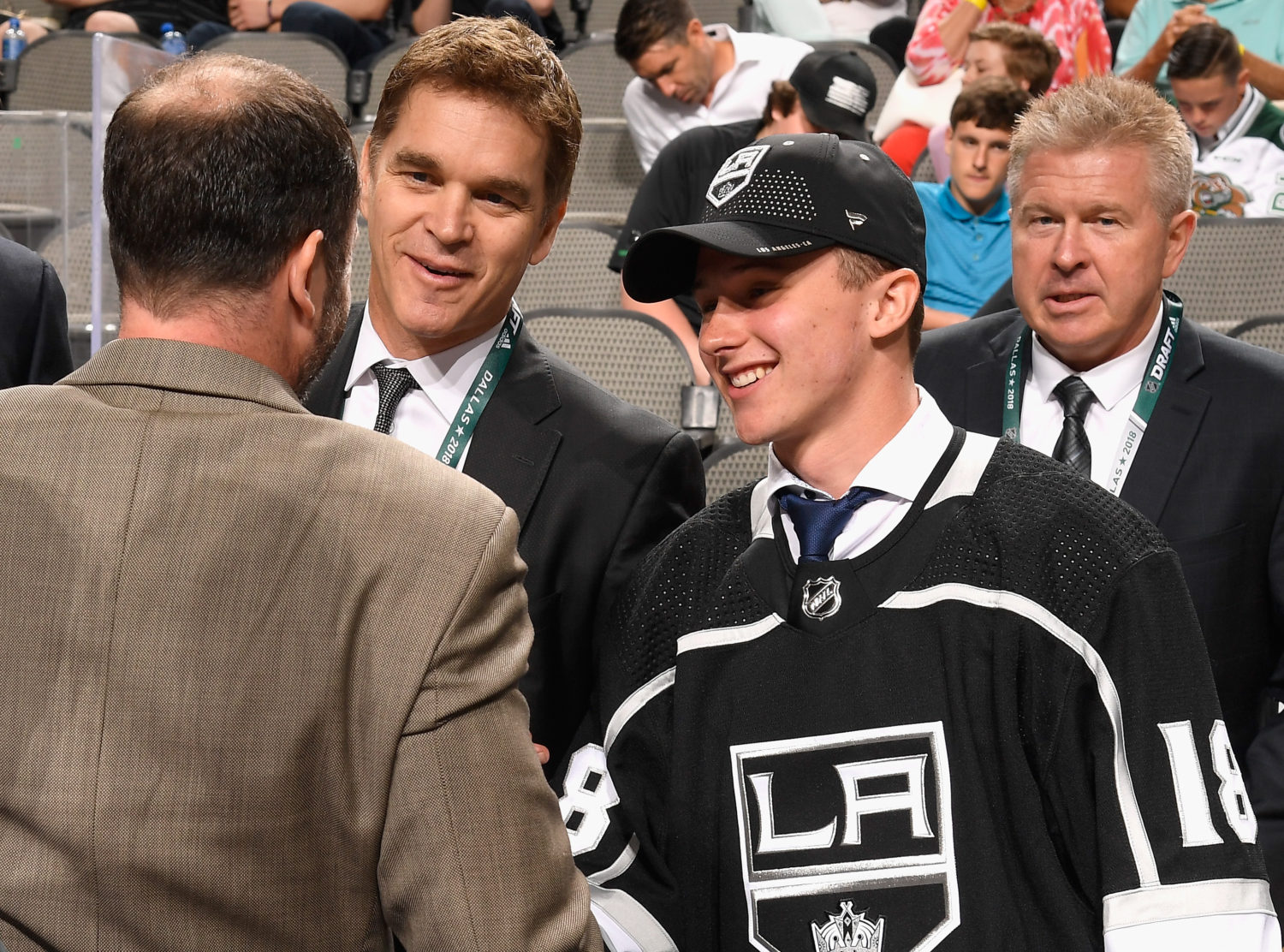“Guys hate me right now. No one on the staff likes me right now,” said Yannetti, who on June 21 and 22 will participate in his 13th draft as a member of the club’s amateur scouting staff, which he now leads.
With an iron fist, that is.
“When the clock strikes midnight and I’m bringing another exercise in on the screen, there’s not a whole lot of guys that like me.”
Always an engaging interview, Yannetti, a native of the Boston suburbs, speaks passionately as he navigates tangential backchannels while lucidly sharing details in philosophy that present scouting as an art form. In a way, it’s similar to Dean Lombardi’s train of thought while addressing the media. Both figures are high on detail and context, and low on clichés.
And while Lombardi’s name comes up as an influence on scouting that led to a pair of Stanley Cups, the identity he helped cultivate – which, very interestingly, Yannetti deemed to be misunderstood – is not the same identity influencing the team’s current drafting habits. Providing additional detail beyond the tepid description that the team is focused on drafting and scouting “speed,’ Yannetti described how he balances eyewitness scouting reports with analytic data while articulating the dynamic in the room and the familiar cross-examination utilized by amateur scouting to produce the most accurate list possible.
Los Angeles owns 10 picks in the upcoming draft, including three of the first 33 selections. Amateur scouts are required to update their list regularly, and on the 15th of the month, the department will have their conference calls in addition to the smaller discussions and individual check-ins. Even before the mid-year and end-of-year scouting meetings – the latter of which concluded late last week – he has a good idea of what the lists will look like.
Throughout the year, Yannetti gave his scouts more personalized “homework assignments” in the name of adding additional color and layers that help provide as accurate of a picture as possible of each potential draftee. As he described it, these assignments incorporated extra video work and fostered discussion and debate as lists were regularly updated.
“I may look at that list and say, ‘OK, these are really the four players that we’re going to be considering at five,’ and it would be a mix of some abstract debate, statistics, some potential video, other scouts’ observations, and then they’re required to put it all together and contrast it with their thoughts and their feelings. It’s almost like defending a thesis,” Yannetti said. “If Tony (Gasparini) has a guy or Ruutts (Christian Ruuttu) has a guy or Byrnesie (Chris Byrne) has a guy or even Rob Blake’s bringing a guy to the discussion, you take all of the information on the four or five guys you have there, and each guy’s got to come up with an opinion and come up with an order, and then be able to debate it on more than one level – not just, ‘I’ve got time for this guy! I like this guy!’ Scouts. If someone says, ‘we’ve got time for this guy’ in the room, all I want to do is hit him in the head with a chair.”
Later discussions with the scouting staff will focus on particular players and more pinpointed material, but Yannetti’s discussions provided a glimpse into how team philosophy is built into scouting and the ways consensus can be built through disagreement.
LA Kings Insider: Under you, and when both you and Mike Futa led Amateur Scouting, there has always seemed to be really healthy cross-examination. How do you raise such topics and these players’ faults? How intricately do you go back and forth with your scouts and challenge their findings? Just because you were saying they hate you these days.
Mark Yannetti: Well, I get to be bad cop a lot, to tell you the truth. When Mike was there, it was a little different. … I’m the only scout without a true area. I know I’m from Boston, but that’s not [inaudible] area. Even when Mike was a co-director, he had an area. For me it’s a good thing, because I’m almost one of those innocents. I don’t have an area. One of my complaints in scouting is ‘I’ve got to get my guy in the list. I’ve got to make sure my guy gets looked at. You know what? Same thing. It’s like we should have a chair in the room just to bash people over the head with. If someone says, ‘my guy,’ discussion’s over. All right, we’ll talk about somebody else. It’s not ‘your guy.’ The list has to be right. So, one of the good things is I don’t have an area. I could just sit there and be the bad cop the whole time, because I’m not trying to make sure that my guy looks good – because I don’t have one. So, basically when any scout says something, I take a contrarian point of view. And in front of the whole group. The problem is I do it enough that they can’t tell when I’m serious. The good thing is they can’t tell when I’m seriously challenging or just being the devil’s advocate. So, they have to put together a cogent and detailed debate and talking points as to why they do it, and what happens is if I make a contrarian point of view, Tony defends his statement and then Chris Byrne comes in and says, ‘I think what Mark said was true, but I think what you said here was good,’ and then all of a sudden Christian Ruuttu will pick up on it. And that’s what happens – now you get a multi-layered debate from four or five different scouts that come from different areas and different ways and backgrounds of looking at things. The way it gets challenged, it’s not as much going to take from Mike and I anymore because he’s moved up. So, it’s more give-and-take just from me and the staff as a whole.
LAKI: Schedule-wise, you have the scouting combine coming up. I have a feeling you enjoy those conversations and talking to the prospects, but I also get the sense that by that point, you’ve put in hundreds and thousands of hours upon hours of work. You know these players intricately, you’ve seen every piece of video of them. How do you use the combine to fill in the pieces that you might not already have?
MY: It’s the same thing. The meetings aren’t just sitting there, talking about players A, B and C and putting them in order, so part of the meetings are devoted to character assessment, character observations. You go to the combine, you talk to the players, hey, if we’re talking USHL Player A, there’s three concerns we have to figure out about them, and you have to challenge them on these three. If we’re talking OHL Player B, there’s absolutely no concerns, all the homework’s been done, just talk to the guy and get a feel for him, see how you like them, see how you feel. There’s ones where there’s one specific thing, good or bad – when you talk to WHL Player C, you have to find out about this one thing. All our research is pointed to this – good or bad. So, you basically have a mission statement, you have an operating manual this year. I think we’re doing 70 players this year. Each one of those players has a detailed list of what needs to be asked and sometimes in what tone it needs to be asked in.
LAKI: There has been that new focus, broadly, that the team is valuing certain abilities such as speed to a greater degree. Again, that’s very generalized, but in the second full season of scouting under Rob, what other variable or asset is targeted than simply ‘speed?’
MY: Here’s what I can say. Again, everyone thinks they’re a genius, everyone to critique everyone from the outside with limited information if any information at all. And I’ll just reference back to Dean, because I can talk about Dean’s philosophy because we don’t employ him anymore. So, anyone who wants to glean what they want to from that, I’m not giving away any trade secrets. But the same thing will apply for Rob’s philosophy. Everyone thought we built the team a certain way, and teams actually tried to copy what we did. That’s natural. You see success, and you try to copy it. We tried to copy certain teams before us. We had our model, and we had our slant on it, but we took some things from successful teams like Detroit or New Jersey or Pittsburgh. We took various things, and then we took those little ingredients and added it with our main ingredient of how we thought the team should be built. But anyone from the outside, you hear it a thousand times. ‘You’ve got to get big, strong, hard guys who are tough and mean and physical and lumbering, and that’s what the Kings did to build a Stanley Cup winner.’ Actually, it’s the furthest from the truth. We looked for three or four assets that I’ve never seen in a publication, anyone that said, ‘this is what the Kings are trying to do.’ It was three or four assets that were absolutely critical other than that size and possession-based style we wanted to play – that was true. But there were three things that we wanted in players other than the one main one of that possession-based style that I never saw anyone ever figure out. So, you had teams copying us at one time, and they’re copying the wrong model. You had people surmising what we were doing, and they were praising us for something that we weren’t doing and criticizing us for something we weren’t doing. It’s funny, so what you see on the surface isn’t really what’s going on. So, with Rob, yeah, we want speed. Well, guess what? There are 30 other teams in the NHL that want speed. It’s not like we’re breaking any new barriers here in terms of that, and anyone who goes, ‘oh, the Kings are going speed,’ again, the Titanic saw the very tip of the iceberg. How’d that work out?
Obviously on the surface we’re trying to make our team faster. The league is a fast, competitive league. The league is a pace-based league. However, take a look at all successful teams that have speed, and I would say that speed is not the number one reason they’re successful. Speed is an ingredient, and it can be an important reason why they’re successful, but I’ll bet you each one of those teams that’s successful has one or two more elements ahead of speed that people don’t recognize right off the bat.
LAKI: Was one of those attributes puck pursuit, retrieving and winning pucks back that they’d lost?
MY: Well, that’s obviously part of possession, so yeah, when we built it with Dean, you have to have possession of the puck. The main tenet is possession of the puck. So, if you don’t have possession of the puck, the second tenet would be to get that puck back. So many things went into that possession-based style. Again, people keep saying that the Kings were a ‘slow’ team, but there wasn’t a faster team in the NHL from goal line to offensive blue line for three years. Maybe Chicago. Again, there’s a whole lot of ways to generate speed, and part of it was how we built our team and part of it was our philosophies and Dean. Just like Rob has philosophies that include speed, but there are other complements to speed. Team A might complement speed one way, and Team B might value it a completely different way. And you can create that in so many ways – again, I’m trying not to be obtuse. One thing I hate to be is vague, because it sucks for people who want to know and want to learn, but you can’t say it. But, again, I’m going to say something obvious, but Rob’s philosophy is a whole lot more involved, in-depth, and there’s so much nuance. When people hear the word ‘philosophy,’ they just get [inaudible]. You can trust me. There are multi layers in terms of how he’s going to implement that philosophy.
LAKI: I know you have your own numbers and histories of picks and the histories of trades and your own database, as well. And again, this is something that you probably aren’t going to be able to – respectfully – share in great detail because I would imagine the team considers this proprietary information, but with Rob Vollman, is there anything you can share about his role or how he helps draft preparation?
MY: Rob Vollman, he’s another layer of protection, really. … It’s checks and balances. Again, I can’t give you anything that Rob specifically does, because it’s proprietary. But what I can tell you is Rob comes at an order of the list in a completely different mindset than a scout comes at the order of the list, and sometimes he arrives at the exact same conclusion the scout arrives at, and sometimes he arrives at a completely, almost directly opposing view of the scout, and I find either one to be unbelievably valuable because … if what Rob says coming at a completely different angle matches 100% what the scout says, there’s a lot of certainty in that pick being right. And if he says something completely different, that’s equally good, because now you’ve got [debate]. Now you say, ‘well, Rob’s model’s saying this, and he’s telling me it’s saying this because of A, B and C,’ and I’m saying, ‘OK, well, the scout’s model is saying this, and it’s saying it for C, D and E … now we talk about them and we debate them, and now – what did we have? 45 minutes, that one player? So, one player whose [analytic evaluation] ran directly opposite to ours, we had a one-hour discussion, and the end result was everyone in the room knew that player intimately. We were 100% confident it was a guy – I’m not going to tell you if he went up or down on the list – but we were 100% confident. We got to a level of 100% with him telling us when the data matches and when the data doesn’t match.
LAKI: The 22nd pick – are there meetings, discussions, philosophies towards that particular pick, or is it as simple as you just select the best player on the list when that pick comes around?
MY: Whoever is there is the person we’re [drafting]. But everything you said in the beginning, there are philosophies for everything. Philosophies don’t really run very differently for each pick. There might be a little bit of nuance compared how we view the 22nd pick, only because logic dictates that the 22nd pick is a different level of pick from the five pick. So, while the philosophy and the mission statement is the same, there’s a little bit of nuance there because at the 22nd pick, you’re losing something. You’re not getting Hughes, Kakko at 22. It’s just not happening. So, at 22, you might get the talent, like, the skill of a Hughes, or you might get the goal scoring drive of a Kakko, and you’re missing the four other elements. Or you might get the assurity of a Larry Murphy, the solid, steadiness of knowing a guy’s going to play, and you may lose out on the dynamic ability of a guy who could run a power play. The nuance is different at that pick. Everything else holds true.
–Lead photo via Brian Babineau/NHLI




Rules for Blog Commenting
Repeated violations of the blog rules will result in site bans, commensurate with the nature and number of offenses.
Please flag any comments that violate the site rules for moderation. For immediate problems regarding problematic posts, please email zdooley@lakings.com.